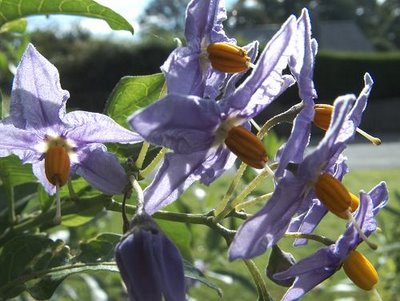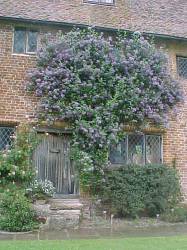Solanum crispum
Family Solanaceae

Blue Potato Vine / Climbing Chilean Potato Tree
This is the best form of this evergreen scandent shrub, most often grown as a climber. It can be regarded as hardy in all but the harshest of conditions. Introduced from Chile in about 1830 it received a well-deserved A.G.M. in 1939. The bright slate blue flowers have a bright yellow beak; it is free flowering over a long season in summer.

Cultivar: 'Glasnevin'
Skill Level: Beginner
Exposure: Full sun
Hardiness: Hardy
Soil type: Chalky/alkaline, Moist, Well-drained/light
Height: 600cm
Spread: 180cm
Time to take cuttings: June to September

The Blue Potato Vine (Solanum crispum glasnerium) scarcely looks like a potato, but is indeed a cousin to the kitchen potato (S. tuberosum). Calling it a Potato Vine still strikes me as odd; as well to call it Eggplant Vine since it's equally related to S. melongena, or Deadly Nightshade Vine since it's related to S. dulcamara.
It's not quite exactly a vine, either, hence its alternative & rather whimsical-sounding name "Potato Tree."
It is often described as a "wall shrub," which best captures its nature. It gets round & bushy, so has to be annually trimmed back to the wall to retain a semblance of vining appearance. It's best to prune it closer to the trellis every spring, taking care not to harm saved bits since these may be brittle. It grows rapidly & blooms profusely after such a trim.
As a Wall Shrub, it's hard to beat, thickly covered over with clusters of the brightest blue & orange little blooms, with rapid growth to the considerable height of ten to fifteen feet in a single year.
It is nearly evergreen in warmer climates than ours though best described as "semi-decidu ous" around here. If the main woody vine is trained well, it thickens up with lovely twists & turns, so it can look interesting in winter even if it behaves deciduously in chillier zones.
ous" around here. If the main woody vine is trained well, it thickens up with lovely twists & turns, so it can look interesting in winter even if it behaves deciduously in chillier zones.
The "Glasneria" variety is bluest of all, & hugely deserving of its Award of Garden Merit given by the Royal Botanical Society.
Pruning incites increasingly vigorous new growth & floweriness.
The bright blue blooms begin in May & continue clear to September or even October (until the first heavy frost). In warmer areas it likes a bit of shade.
In late August & September, it becomes covered over with yellow-orange berries, soft as tomatos, but hideously bitter tasting & mildly toxic.
Gardeners' reports on its hardiness for zone 8 or chillier are often contradictory. Some claim they found it to be fragile in Zone 8, & others are just as adamant that theirs did spectacularly well even in areas colder than ours. Peoples' varied experiences probably has a lot to do with how well it was situated for its winter experience. If it gets through its first two years fine, it will just be hardier & hardier.

Blue Potato Vine / Climbing Chilean Potato Tree
This is the best form of this evergreen scandent shrub, most often grown as a climber. It can be regarded as hardy in all but the harshest of conditions. Introduced from Chile in about 1830 it received a well-deserved A.G.M. in 1939. The bright slate blue flowers have a bright yellow beak; it is free flowering over a long season in summer.

Cultivar: 'Glasnevin'
Skill Level: Beginner
Exposure: Full sun
Hardiness: Hardy
Soil type: Chalky/alkaline, Moist, Well-drained/light
Height: 600cm
Spread: 180cm
Time to take cuttings: June to September

The Blue Potato Vine (Solanum crispum glasnerium) scarcely looks like a potato, but is indeed a cousin to the kitchen potato (S. tuberosum). Calling it a Potato Vine still strikes me as odd; as well to call it Eggplant Vine since it's equally related to S. melongena, or Deadly Nightshade Vine since it's related to S. dulcamara.

It's not quite exactly a vine, either, hence its alternative & rather whimsical-sounding name "Potato Tree."
It is often described as a "wall shrub," which best captures its nature. It gets round & bushy, so has to be annually trimmed back to the wall to retain a semblance of vining appearance. It's best to prune it closer to the trellis every spring, taking care not to harm saved bits since these may be brittle. It grows rapidly & blooms profusely after such a trim.
As a Wall Shrub, it's hard to beat, thickly covered over with clusters of the brightest blue & orange little blooms, with rapid growth to the considerable height of ten to fifteen feet in a single year.
It is nearly evergreen in warmer climates than ours though best described as "semi-decidu
 ous" around here. If the main woody vine is trained well, it thickens up with lovely twists & turns, so it can look interesting in winter even if it behaves deciduously in chillier zones.
ous" around here. If the main woody vine is trained well, it thickens up with lovely twists & turns, so it can look interesting in winter even if it behaves deciduously in chillier zones.The "Glasneria" variety is bluest of all, & hugely deserving of its Award of Garden Merit given by the Royal Botanical Society.
Pruning incites increasingly vigorous new growth & floweriness.
The bright blue blooms begin in May & continue clear to September or even October (until the first heavy frost). In warmer areas it likes a bit of shade.
In late August & September, it becomes covered over with yellow-orange berries, soft as tomatos, but hideously bitter tasting & mildly toxic.
Gardeners' reports on its hardiness for zone 8 or chillier are often contradictory. Some claim they found it to be fragile in Zone 8, & others are just as adamant that theirs did spectacularly well even in areas colder than ours. Peoples' varied experiences probably has a lot to do with how well it was situated for its winter experience. If it gets through its first two years fine, it will just be hardier & hardier.







0 Comments:
Post a Comment
<< Home